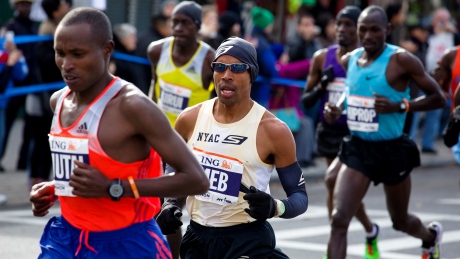我最近正進行階段性的訓練來提高我馬拉松的速度,但如何於10英里(16公里)內維持較高的速度並不太費力的絕竅,目前不太容易能歸納出來。跑步最基礎的模式,就是跑步是一連串的小跳躍,最簡單的計算方式是步伐寬及每分鐘的步伐數(頻率)。
我用GPS跟計步器來計算,但除此之外仍有其他的方法來計算步伐節奏及步伐寬。你能夠在跑步機上以馬拉松的速度去測量你的步伐寬。
Jack Daniels教練以其自身對於快跑者的觀察,他們通常都以較快的頻率跑步,在1984年的奧林匹克運動會中, 菁英跑者最快的跑步頻率是180。在他的網誌(請見:blog)中提到,高頻率的跑步須透過更多的訓練才能達到,業餘跑者很難達到高頻率。更甚者,他提到短跑者(例如800公尺或1500公尺)的步伐頻率是更快的,但或許這並不是最有效率的跑法。低頻率指的是身體抬得較高且腳在空中的時間較長,腳落地時也更顯困難。由於落地較困難,通常腳接觸地面的時間也較長。
然而,事情並非如此簡單。如果我想將跑步的頻率從172~176增強到182,我的速度並不會從每公里5分鐘減少到每公里4:15。事實上,我在為富邦馬拉松訓練時,發現增加跑步的速度比增加步伐寬來的容易些。跑步的頻率本質上並不會必然地轉換成更快的速度。但接下來發生了什麼事?我增加了我跑步的頻率,現在我步伐寬能從1.1公尺加寬到1.25公尺。
在這篇文章中,Steve Magness教練在2007年World Championships賽事中觀察了三位跑者,前三名分別為ekele、 Sihine及 Mathathi。他們三位都用不一樣的方式在比賽中跑步,但他們基本上都以同樣的速度完成最初的9公里。
Bekele用較低頻率但較寬步伐。Mathath用較高的頻率但較短的步伐。Sihine則是介於前兩者的頻率及步伐寬之間。
但最後一公里時卻迥然不同。Bekele從頻率190提升到216。Sihine先增加步伐寬,然後加快他的頻率。Mathathi則是增加了他的步伐寬。重要的是各跑者不是用步伐寬補償頻率,就是用頻率補償步伐寬。就我而言,我似乎可以從頻率及步伐寬的調整來增加我的跑步速度。例如:為了以每公里5分鐘的速度跑步,我提高我的頻率並試著與Jack Daniel另人驚艷的180頻率更接近。我嘗試在訓練中以較輕快的步伐跑步。我的最高頻率是174或176。於此頻率下,我想增加我的步伐寬。
接著,我想再次加快我的馬拉松速度,如果我能提高頻率到180(或更高),此目標是可達成的。有數種方式可以提高頻率或可增強腿部力量讓步伐更寬。頻率數並無一個不能達到的數字,頻率跟步伐寬是一個可發展的目標,就像最高攝氧量一樣。事實上Jack Daniels並非被特別標定在頻率180。只是該數字被認為是精英跑者最快的頻率。
當參考2007年World Championships最快的跑者時,最令人驚艷的是,Bekele的步伐寬僅1.6公尺,Mathathi 及 Sihine分別是1.67及1.7公尺。為什麼最矮的跑者能有最長的步伐寬?他在最後一公里達到比過往競賽中更高的頻率,並贏得了比賽。我很想知道他如何訓練自己讓他達到如此程度。這讓我相信影響速度的原因必定不止一種,就像Jack Daniels所做的。
市面上有很多很棒的工具可以幫助跑者。有很多運動手錶能夠藉由計步器來計算頻率,甚至Garmin或Adidas所出的錶不用計步器也可以計算頻率。該手錶透過感應手腕的移動來計算。但我發現我的手錶能測量我在穿不同鞋子時的速度。Garmin最新的運動錶(Forerunner 620)甚至能告訴你跑步時你的腳停留在地面的時間及離開地面所需的時間。我認為這對跑步來說是很棒的數據,頻率的降低會讓腳停留及離開地面的時間被拉長。
在2013年紐約馬拉松中,我觀察到Geoffrey Mutai擊敗別人,他戴的是Garmin最基礎的Forerunner 110。我不知道他在訓練中是戴什麼手錶,但我了解到迷失在數據中並不能取代艱苦的訓練及努力。
Recently I have been taking steps to improve my marathon speed and though it hasn’t been easy I can point to a few steps that have allowed me to maintain faster speeds for distances of up to 10 miles or 16km without too much an effort. In its most basic form, running is a series of hops in which the easiest factors to calculate are stride length and how many steps you take per minute (cadence).
I use a GPS watch with foot pod, but there are ways to calculate cadence and stride length without them. You can count steps on a treadmill simulating marathon speed and also use the same treadmill or track to calculate average stride length.
Coach Jack Daniels has mentioned that faster runners have higher cadence and in his observations of runners at the 1984 Olympic Games the minimum cadence of elite runners is 180. In his blog he writes that higher cadence comes as a result of more running and training, as non-elite runners seldom display high cadence. Moreover, he writes that cadence is even higher for shorter distances like the 800m and 1500m but such high cadence is probably not the most economical. Slower cadence often means that the body is rising more and the foot is spending more time in the air and consequently coming down harder with each landing. By landing harder, the foot is usually spending more time on the ground.
However, things aren’t this simple. If I am to increase my cadence of 172-176 to 182 my pace will not automatically increase from 5:00/km to 4:15/km. In fact, while training for the Fubon Half Marathon I discovered that to increase my speed it’s easier to just stretch my stride length. Essentially, my cadence has an upper limit where increases do not necessarily translate into more speed. But what happens afterwards? I can only stretch my cadence so much, and currently it has increased from 1.1m to 1.25m.
In this article, coach Steve Magness looks at 3 runners in the 10K at the 2007 World Championships. The top 3 finishers were Bekele, Sihine, and Mathathi. None of the 3 runners had the same approach to running the race. They all basically ran the same speed for the first 9k, where Bekele had low cadence and long stride length. Mathathi had high cadence and short stride length and Sihine was between both.
But in the last 1k everything changed. Bekele went from 190 to 216 cadence. Sihine increased his stride length and then increased his cadence, and Mathathi increased his stride length. The important point is that each runner compensated stride length for cadence or vice versa. In regards to me, it seems that I can work on both aspects of running to increase my speed. For example, in order to reach 5:00/km I spent some time to increase my cadence to get to a number closer to Jack Daniel’s magic 180. I focused on taking quick light steps during my training. Maybe it’s my height but my cadence tops at 174 or 176. At this point, I plan on increasing my stride length.
Later on, when I want to increase my marathon speed again, it would make sense to work on turnover to see if I can improve my cadence to 180 or above. There are drills to increase cadence or maybe increase leg power to improve stride length. But there is no magic number for cadence and if anything, both stride length and cadence can be seen as moving targets similar to a VO2 max. In fact Jack Daniels doesn’t really seem to specifically state a 180 cadence. He just notes that it seems to be a minimum among elite runners.
The craziness is when you consider the heights of the runners at the 2007 World Championships. Bekele is only 1.6m and Mathathi and Sihine are 1.67 and 1.7m, respectively. How is it that the shortest runner has the longest stride length? Yet in the last 1km he ups his cadence to a level higher than his competition, and wins the entire race. I wonder how his training allowed him to reach these levels. It makes me believe that speed can be influenced by more than the one factor made famous by Jack Daniels.
There are some great tools to help runners. Many watches can count cadence using a foot pod and some of the new watches from Garmin or Adidas don’t even need a foot pod. They calculate cadence by sensing wrist motion. But, as I found out, my cadence can range depending on what shoe I wear to what speed I am running. Garmin’s newest flagship running watch, the Forerunner 620, can even tell you how much time your feet are on the ground to how high they lift off it. I think it paints a great data picture of the run, but it’s easy to mentally note that as cadence slows more time will be spent both in the air and ground.
When I watched Geoffrey Mutai destroy his competition in the 2013 New York City marathon, I noted he was wearing a basic Garmin Forerunner 110. I don’t know what watch he uses during his training but I do understand it’s easy to get lost in numbers that cannot replace a commitment to hard work and pain.

